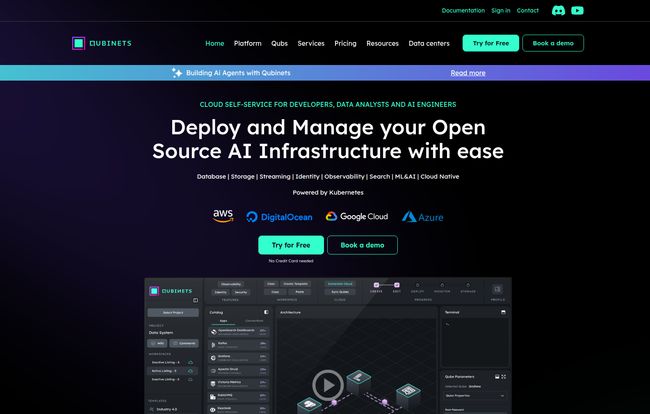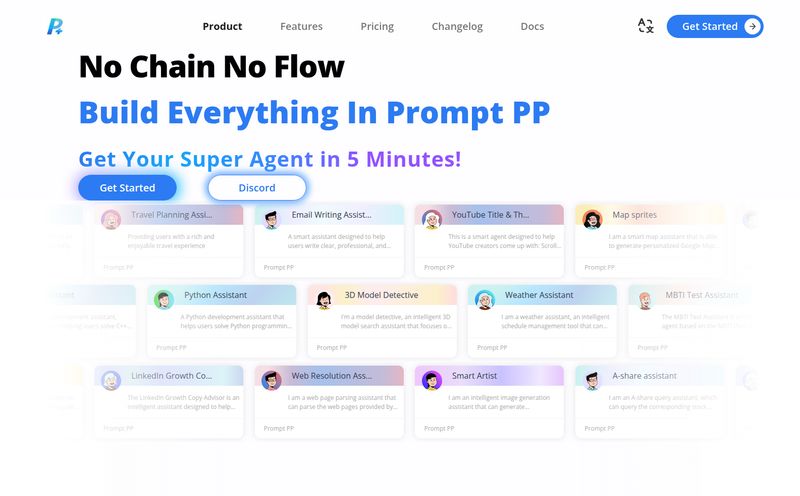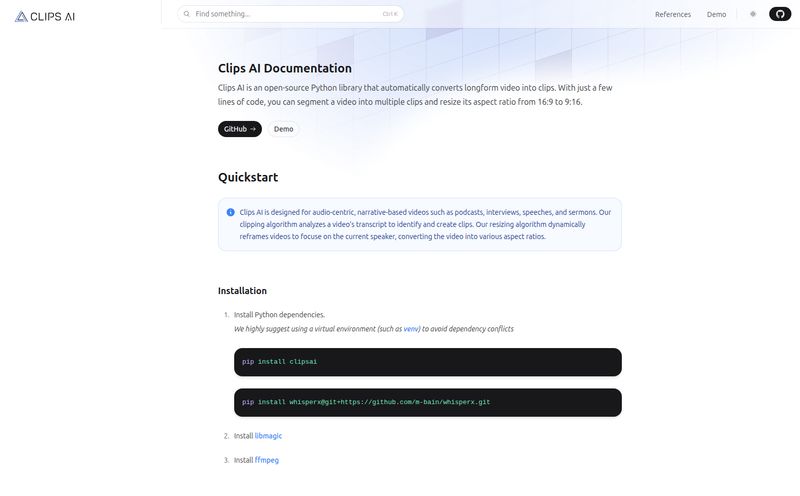If you've worked in tech for more than a few years, you've felt the pain. The late nights spent wrestling with configuration files. The soul-crushing complexity of setting up a new production environment. And don't even get me started on Kubernetes. It's powerful, yes. A standard, absolutely. But friendly? Not on your life. For many teams, especially those diving into AI and big data, Kubernetes can feel like being handed the keys to a Formula 1 car when all you wanted was a reliable sedan to get to work.
I’ve been in the trenches, sifting through endless YAML files, trying to figure out why a pod is crash-looping at 3 AM. It’s a rite of passage, I guess. But what if it didn’t have to be? I recently stumbled upon a platform called Qubinets, and my initial skepticism has slowly, but surely, turned into genuine curiosity. It promises to tame the beast. To make deploying complex AI and data stacks... simple. A bold claim. Let's see if it holds up.
So, What on Earth is Qubinets?
In a nutshell, Qubinets is an open-source platform designed to put a friendly face on the monster that is AI and big data infrastructure management. Think of it as a super-smart layer that sits on top of Kubernetes, hiding most of the scary, complicated bits. It lets developers, data analysts, and AI engineers focus on their actual jobs—writing code, analyzing data, building models—instead of becoming reluctant DevOps engineers.
The core idea is to provide cloud self-service. You need a PostgreSQL database? A Kafka stream? A Milvus vector database for your new AI project? Instead of filing a ticket and waiting two weeks for the ops team, you just… click a few buttons in a clean UI. That's the dream, anyway.

Visit Qubinets
Why We Even Need a Tool Like This
The modern tech stack is a beautiful, sprawling mess. We need databases, message queues, object storage, search engines, and a dozen other services just to get a single application off the ground. When you add AI and big data into the mix, the complexity skyrockets. Now you need data pipelines, vector stores, and MLOps tooling.
Traditionally, stitching all this together is a Herculean task. It requires deep expertise in cloud platforms (like AWS, GCP, Azure) and Kubernetes. This expertise is expensive and hard to find. I've seen projects delayed for months just waiting for the infrastructure to be ready. Qubinets is swinging for the fences here, trying to solve this very problem. They claim to save an average of 80 developer hours per project. That’s two full work weeks! If that's even half true, it's a massive win.
A Peek Behind the Curtain: How Qubinets Works
It’s not magic, though it kind of feels like it. Qubinets offers what they call “Managed Open Source.” You choose the open-source tool you need from their catalog—think Redis, MongoDB, ClickHouse, etc.—and it handles the deployment, connection, and management on your Kubernetes cluster. It's all done through a graphical user interface, which is a welcome change from the command-line purgatory many of us live in.
The process looks something like this:
- Build: You select the services you need.
- Connect: The platform helps wire everything together.
- Deploy: You push the button, and it deploys to your cloud environment.
You still retain full control over your accounts and resources, it just automates away the tedious, error-prone setup process. It's like having a seasoned DevOps pro on your team, but one that never sleeps or asks for a raise.
My Favorite Qubinets Features
Managed Open Source Without the Headaches
This is the big one for me. I love open-source software, but I don't always love managing it. The patching, the security vulnerabilities, the version compatibility issues... it's a full-time job. The idea of having a platform that provides these tools as a managed service, but still on my own infrastructure, is incredibly appealing. It’s the best of both worlds: the power of open source without the operational burden.
True Developer Self-Service is Here
The friction between development and operations teams is a tale as old as time. Devs want to move fast and build things; Ops wants to keep everything stable and secure. Qubinets acts as a peacekeeper. By giving developers a safe, sandboxed way to provision their own infrastructure, it removes a major bottleneck. No more waiting. No more "it works on my machine." Just faster prototyping and deployment.
Cloud Infrastructure That Just… Works
At its core, Qubinets is selling simplicity. It's an "Infrastructure as a Service" platform that abstracts away the underlying cloud provider details. This means you can get your open source apps running on any cloud without having to be an expert in every single one. For teams working across different cloud environments, this consistency is a huge advantage.
The All-Important Question: Qubinets Pricing
Alright, let's talk about the cost. No tool is great if you can't afford it. Qubinets has a pricing structure that seems pretty thoughtful and scales with you. I always appreciate a transparent pricing page, and theirs is quite clear. Here's a quick breakdown as I see it:
- Community Plan: This one is Free Forever. You heard me. For personal use, testing, learning, or small projects, this is a fantastic entry point. You get one cluster, 5 workspaces, and standard features. It's a genuine free tier, not just a time-limited trial.
- Professional Plan: At $10 per user per month, this is for professionals and small teams. It bumps you up to 10 clusters and unlimited workspaces, and adds features like advanced user management and a private AppStore repo. It seems very reasonable for the added power.
- Business Plan: For agencies and larger teams running production workloads, this plan comes in at $50 per user per month. It includes everything from Professional plus single sign-on (SSO), managed observability, and priority support. This is where it gets serious.
- Enterprise Plan: This is the classic "Contact Us" tier for large organizations that need all the bells and whistles, like compliance, security certifications, and a dedicated account manager.
Honestly, the existence of a robust free plan is a huge vote of confidence in their own product. It lets you kick the tires thoroughly before committing any cash.
Is Qubinets The Right Fit for Your Team?
So, who should be looking at this? In my opinion, Qubinets hits a sweet spot for a few groups. Startups and small-to-medium businesses that need to build powerful AI/data applications but don't have a dedicated DevOps army. Data science teams who want to rapidly prototype and deploy models without getting bogged down in infrastructure. And even individual developers or freelancers who want to leverage enterprise-grade tools for their projects without the enterprise-grade complexity.
If you're a massive enterprise with a 100-person platform engineering team that has already built a custom internal developer platform, maybe this isn't for you. But for everyone else? It’s definitely worth a look.
The Honest Truth: Pros and Potential Gotchas
What I Really Like
The focus on code over configs is a philosophy I can get behind. The sheer speed of being able to build, connect, and deploy in a few clicks is a massive selling point. The simple graphical UI lowers the barrier to entry significantly, and managing everything from one place is just... clean. Plus, the potential to lower expensive setup fees and sidestep the skills gap is a real-world benefit that will resonate with any budget holder.
A Few Things to Keep in Mind
Now, it’s not a magic wand. The platform is built on Kubernetes, and while it hides a lot of the complexity, having some foundational knowledge of container and cloud concepts will certainly help. You're not completely insulated from teh reality of what's happening under the hood. There's likely a bit of a learning curve to understand the Qubinets way of doing things (their 'Qub' concept). And, like any managed platform, you are reliant on the cloud providers and services they choose to support. It's not a deal-breaker, but it's something to be aware of.
Final Thoughts: A Breath of Fresh Air for Ops?
After digging in, I'm optimistic. Qubinets feels like a step in the right direction. For years, the industry has been making infrastructure more powerful, but also more complex. Tools like this that focus on simplification and developer experience are not just nice-to-haves; they're becoming necessary to keep pace.
It won't solve every problem for every team, but it directly attacks one of the biggest bottlenecks in modern software development: the infrastructure roadblock. By making AI and big data tooling more accessible, Qubinets could genuinely empower more teams to build amazing things. And I, for one, am excited to see where it goes.
Quick Questions Answered: The Qubinets FAQ
- 1. What cloud providers does Qubinets support?
- Qubinets is designed to be cloud-agnostic and works with major providers like AWS, Google Cloud Platform (GCP), and Azure. The goal is to provide a consistent experience across different cloud environments.
- 2. Do I need to be a Kubernetes expert to use Qubinets?
- No, you don't need to be an expert. The platform is specifically designed to abstract away much of Kubernetes' complexity. However, a basic understanding of what containers and clusters are will help you get the most out of the tool.
- 3. Is Qubinets secure for production workloads?
- Yes, the platform is built with production in mind. The Business and Enterprise plans offer features like single sign-on (SSO), audit logs, and dedicated support to meet the security and compliance needs of larger organizations.
- 4. Can I integrate my own custom applications or tools?
- Absolutely. While Qubinets offers a curated marketplace of open-source services, it also allows you to bring your own code and deploy your custom applications, giving you the flexibility to build your entire stack on the platform.
- 5. What kind of support can I expect?
- Support levels vary by plan. The free Community plan relies on community support. The Professional plan offers standard support, while the Business and Enterprise tiers provide priority support, dedicated account managers, and onboarding assistance.
- 6. What does the '98% cheaper database costs' claim mean?
- This claim likely refers to the cost savings of running open-source databases on your own Kubernetes infrastructure via Qubinets, compared to paying for a fully managed, proprietary database service directly from a cloud provider (like Amazon RDS or Google Cloud SQL), which often comes at a significant premium.



